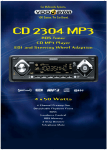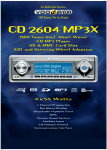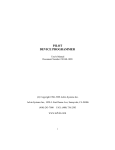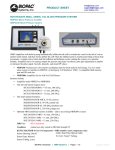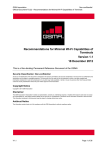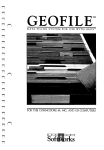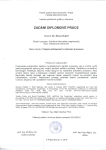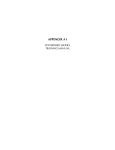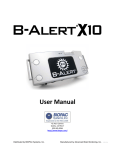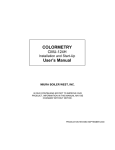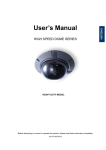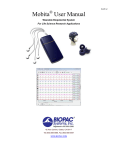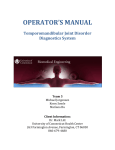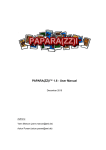Download Biopac Student Lab Tutorial
Transcript
BASIC TUTORIAL Manual Revision 3.7.3 090208 Jocelyn Mariah Kremer Documentation BIOPAC Systems, Inc. William McMullen Vice President BIOPAC Systems, Inc. BIOPAC® Systems, Inc. 42 Aero Camino, Goleta, CA 93117 Phone (805) 685-0066 Fax (805) 685-0067 [email protected] www.biopac.com Welcome to the Biopac Student Lab! Biopac Student Lab System The Body Electric Waveform Concepts Sample Data File BSL Display Display Tools Scale & Grid Controls Measurements Markers Menu Options Journal Save Data Printing Quit BSL Running a Lesson Lesson Specific Buttons 2 2 3 4 5 7 8 14 15 22 24 27 30 31 33 34 40 2 Biopac Student Lab Welcome to the Biopac Student Lab! This short Tutorial covers basic concepts that make the Biopac Student Lab System unique and powerful, and provides detailed instructions on how to use important features of the program for data recording and analysis. You are encouraged to open the Sample Data File and follow along as you complete the Tutorial. Have fun experimenting with the display and analysis functions of the Biopac Student Lab—interacting with the software as the Tutorial explains functionality will ease the learning curve. For more information, see your instructor or review the Software Guide. Biopac Student Lab System The Biopac Student Lab System is an integrated set of software and hardware for life science data acquisition and analysis. Biopac Student Lab Software Biopac Student Lab Hardware MP3X Acquisition Unit Transducers Software The inputs on the MP acquisition unit are referred to as Channels. The channel input ports are on the front of the MP3X unit and are labeled CH1, CH2, CH3, and CH4. Th Analog Out port on the back of the MP3X Unit allows signals to be amplified and sent out to devices such as headphones; on the MP36, Analog Out is a built-in low voltage stimulator. The Biopac Student Lab software includes 18 guided Lessons and BSL PRO options for advanced analysis. The software will guide you through each Lesson with buttons and text and will also help you manage data saving and data review. Hardware Includes the MP3X Acquisition Unit (MP36, MP35 or MP30), electrodes, electrode lead cables, transducers, headphones, connection cables, wall transformer, and other accessories. HOW THE BIOPAC STUDENT LAB WORKS One way to think about how the Biopac Student Lab works is to think about it as being like a video camera connected through a VCR into a television set. In a general sense, a video camera records information about the outside world and then converts the images it collects into an electronic format that can be passed to the VCR and television. The images the VCR captures are stored on videotape to be archived or viewed at a later date. Like a video camera, the Biopac Student Lab records information about the outside world, although the types of information it collects are different. Whereas cameras record visual information, the Biopac Student Lab records information (“signals”) about your physiological state, whether in the form of your skin temperature, the signal from your beating heart or the flexing of an arm muscle. Basic Tutorial 3 This physiological information is transferred via a cable from you (or whomever the information is being recorded from) to the Biopac Student Lab. The type of physiological signals you are measuring will determine the type of device on the end of the cable. When the signal reaches the Biopac Student Lab, it is converted into a format that allows the data to be read by a computer. Once that is done, the signal can be displayed on the computer screen, much like the video images from the camera are displayed on the television set. It takes about 1/1,000 of a second from the time a signal is picked-up by a sensor until it appears on the computer screen. The computer’s internal memory can save these signals much like the VCR can save the video images. Like a videotaped record, you can use the Biopac Student Lab to recall data that was collected some time ago. And like a video, you can edit and manipulate the information stored in a Biopac Student Lab computer file. The Biopac Student Lab software takes the signal from the MP unit and plots it as a waveform on the computer screen. The waveform of the signal may be a direct reflection of the electrical signal from the MP channel (amplitude is in Volts) or a different waveform that is based on the signal coming into the MP unit. • For example, the electrical signal into the MP unit may be an ECG signal, but the software may convert this to display a Beats Per Minute (BPM) waveform. The Body Electric When most people think of electricity flowing through bodies, they think of rather unique animals, such as electric eels, or of rare events such as being struck by lightning. What most people don’t realize is that electricity is part of everything our bodies do...from thinking to doing aerobics—even sleeping. In fact, physiology and electricity share a common history, with some of the pioneering work in each field being done in the late 1700’s by Count Alessandro Giuseppe Antonio Anastasio Volta and Luigi Galvani. Count Volta, among other things, invented the battery and had a unit of electrical measurement named in his honor (the Volt). These early researchers studied “animal electricity” and were among the first to realize that applying an electrical signal to an isolated animal muscle caused it to twitch. Even today, many classrooms use procedures similar to Count Volta’s to demonstrate how muscles can be electrically stimulated. Through your lab work, you will likely see how your body generates electricity while doing specific things like flexing a muscle or how a beating heart produces a recognizable electric “signature.” Many of the lessons covered in this manual measure electrical signals originating in the body. In order to fully understand what an electrical signal is requires a basic understanding of the physics of electricity, which properly establishes the concept of voltages, and is too much material to present here. All you really need to know is that electricity is always flowing in your body, and it flows from parts of your body that are negatively charged to parts of your body that are positively charged. As this electricity is flowing, sensors can “tap in” to this electrical activity and monitor it. The volt is a unit of measure of the electrical activity at any instant of time. When we talk about an electrical signal (or just signal) we are talking about how the voltage changes over time. Electricity is part of everything your body does...from thinking to doing aerobics—even sleeping The body’s electrical signals are detected with transducers and electrodes and sent to the MP3X acquisition unit computer via a cable. The electrical signals can be very minute—with amplitudes sometimes in the microVolt (1/1,000,000 of a volt) range—so the MP3X amplifies these signals, filters out unwanted electrical noise or interfering signals, and converts these signals to a set of numbers that the computer can read. These numbers are sent to the computer via a cable and the Biopac Student Lab software then plots these numbers as waveforms on the computer monitor. 4 Biopac Student Lab Waveform Concepts A basic understanding of what the waveforms on the screen represent will be useful as you complete the lessons. Amplitude is determined by the BSL System based on the type of MP input. The units are shown in the vertical scale region; the unit for this example is Volts. Time is the time from the start of the recording, which is to say that when the recording begins it does so at what the software considers time 0. The units of time are shown in the horizontal scale region along the bottom of the display; the unit for this example is milliseconds (1/1,000 of a second). Units Vertical (amplitude) Scale start of recording (time 0) Units Horizontal (time) Scale Diving a little deeper into what a waveform represents, you are actually looking at data points that have been connected together by straight lines. These data points are established by the Biopac Student Lab hardware by sampling the signal inputs at consistent time intervals. These data points can also be referred to as points, samples, or data. The time interval is established by the sample rate of the BSL hardware, which is the number of data points the hardware will collect in a unit of time (normally seconds or minutes). The BSL software stores these amplitude values as a string of numbers. Since the sample rate of the data is also stored, the software can reconstruct the waveform. • Sampling the data is very similar to how a VCR records images from a camera by taking snapshots of the image at specific time intervals. When it plays back the tape, it displays the captured images in quick succession, and our eyes can’t see the starting and stopping. Likewise, when you look at the waveform, you see a continuous flow rather than the data points and straight lines. The Biopac Student Lab Lessons software always uses the same sample rate for all channels on the screen, so the horizontal time scale shown applies to all channels, but each channel has its own vertical scale. A channel’s vertical scale units can be in Volts, milliVolts, degrees F, beats per minute, etc. A baseline is a reference point for the height or depth (“amplitude”) of a waveform. • Amplitude values above the baseline appear as a “hill” or “peak” and are considered positive (+). • Amplitude values below the baseline appear as a “trough” or “valley” and are considered negative (−) Basic Tutorial 5 Sample Data File This Tutorial is designed for you to follow along with a sample data file on a computer without Biopac Student Lab hardware attached. This means that you can complete the Tutorial on a computer outside of the classroom/lab—perhaps at the library, computer lab or home—just as you will always have those options for analyzing data outside the lab. Open the SampleData-L02 file as directed below. 1. Turn the computer ON. 2. Use the desktop icon or the Windows Start menu to open BSL Lessons 3.7. To launch the program use desktop icon or use the Windows® Start menu, click Programs and then select: 3. In the No Hardware mode, the BSL software will open to a standard Open Dialog. Note: A hardware dialog may be generated. • If the program was installed with the hardware option but there is no hardware connected, the following dialog may be generated: For this tutorial (and all future analysis), click OK to enter the Review Saved Data mode. 4. Open the Data Files folder. • The program may open the Data Files for you. If so, skip to the next step. • For future analysis, use this dialog to browse to your data files. Open the Data Files folder, which is in the Biopac Student Lab program folder. 6 Biopac Student Lab 5. Open the Sample Data folder. Open the Sample Data folder, which is in the Data Files folder. 6. Open the SampleData-L02 file. Select and open the SampleData-L02 file, which is in the Sample Data folder. Don’t worry — you can’t lose or damage the SampleData-L02 file. Basic Tutorial 7 BSL Display The display includes a Data window and a Journal and both are saved together in one file. • The Data window displays the waveforms and is where you will perform your measurements and analysis. • The Journal is where you will make notes. You can extract information from the Data window and put it in the Journal and you can export the Journal to other programs for further analysis. The Biopac Student Lab software has a variety of Display Tools available that allow you to change the data display by adjusting axis scales, hiding channels, zooming in, adding grids, etc. This can be very useful when you are interested in studying just a portion of a record, or to help you identify and isolate significant data in the record for reporting and/or analysis. 7. Review the display to identify the display elements of the Data Window and the Journal. • The Data Window displays waveform(s) during and after recording, and is also called the "Graph Window." Up to eight waveforms can be simultaneously displayed, as controlled by the software and lesson requirements. • The Journal works like a standard word processor to store recording notes and measurements, which can then be copied to another document, saved or printed. The SampleData-L02 file should open as shown below: Biopac Student Lab Display Top down, the sections of the display are: Title Bar (BSL program name and file name) Menu Bar (File, Edit, Display, Lessons) Tool Bar (lesson specific buttons, such as Overlap and Split) Measurement Region (channel, type, result) Channel Box(es) and Channel Label(s) Marker Region (icons, text and menu) Data window — waveform display Horizontal scroll for Data Window Display Tools (to the right of the Horizontal Scale) — Selection, I-beam, and Zoom icons Journal Tool Bar (Time and Date icons) Journal 8 Biopac Student Lab Display Tools The BSL allows you complete flexibility in how the data is viewed. Chart recorders lock you into one view, but with the BSL you can expand or compress the visual scales to aid in data analysis. The Data window display is completely adjustable, which makes data viewing and analysis easier. • View multiple channels or hide channel(s) from the display view. • Zoom in on specific segments to take measurements, examine anomalies, etc. • View the entire record at one time to look for trends, locate anomalies, etc. Editing and Selection Tools 8. Locate the editing and selection tool icons in the lower right of the Data Window. A good starting point is to understand the editing and selection tools. In the lower right of the data window there are three icons representing the Arrow, “I-Beam,” and Zoom tools. To select any of these tools simply click the mouse on the desired icon, and it will appear recessed to indicate it is active (the Selection tool is active/recessed in the picture above). Each tool activates a different cursor in the display window: Arrow cursor I-beam cursor Channel boxes are in the upper left of the data window. They enable you to identify the active channel and hide channels from view, so as to concentrate on or print out only specific waveforms at a time. Active Channel 9. Click in the CH 1 box to make that the “active channel.” • • Zoom cursor The channel box of the active channel will be generated to be recessed, and the label for the active channel will be highlighted on the left edge of the channel display. The display can Show one or more data channels, but only one channel can be “active” at any time. The “active” channel box appears recessed. The Label for the active channel is displayed to the right of the channel boxes and highlighted in the display region. You can also click on the channel label to make a channel active. 10. Click in the CH 40 box and note how the label changes. CH 1 active, CH 3 and CH 40 shown (note “Force” is highlighted on the left edge) CH 1 and CH 3 shown, CH 40 active Show/Hide a channel 11. To Show or Hide a channel hold the “Ctrl” (Control) key down and click on the Channel box. a. Hide CH 40. When you Hide a channel, the data is not lost, but simply hidden, so that you can focus on specific channel(s). Hidden channels can be brought back into view at any time. The channel box displays “slash marks” when it is hidden. Basic Tutorial 9 b. Show CH 40. c. Hide CH 40. • Showing a channel enables the channel display but does not make it the active channel. • Hiding an active channel does not prevent it from being the active channel. Show/Hide Grid Display 12. Pull down the File menu and scroll down to select Display Preferences. 13. Select Hide Grids to turn the grid display OFF, and click OK. 14. Review the display without grids. Another powerful feature is the ability to Show or Hide the grid display. A grid is a series of horizontal and vertical lines that assist the eye with finding data positions with respect to the horizontal and vertical scales. The horizontal grid is the same for all channels (since they share the Time base), but the vertical grid can be set for each channel. To turn grids on and off in the Review Saved Data mode, simply choose Display Preferences from the File menu. A Grids dialog will be generated. Make your selection and click OK. 10 Biopac Student Lab Note that the Grids display affects all channels. If you show a channel that was hidden when Grids were activated, the grid display will show on the channel. 15. Show Grids. To adjust the grids, see Scales & Grids on page 14. Scroll - Horizontal 16. Locate the Horizontal Scroll Bar at the lower edge of the display. You can move to different locations in the record by using the horizontal scroll bar. Since the horizontal scale applies to all channels in view, it will move every waveform simultaneously. The scroll bar is active when only a portion of the waveform is in view. To move forward or backward, select and drag the scroll box or click on the left or right arrow. For a continuous scroll, click on the arrow and hold down the left mouse button. If the entire waveform is displayed, the scroll bar will dim. 17. Use the Horizontal Scroll to reposition the data with respect to time. • Note that both waveforms moved. This is because the horizontal scale is the same for all channels. In the sample file, the horizontal scale represents Time in seconds. The software will set the most appropriate Time option for each signal. Notice the Horizontal Scale range on the bottom changes to indicate your position in the record. Scroll – Vertical 18. Locate the Vertical Scroll Bar along the right edge of the display. Basic Tutorial 11 A similar scroll bar can be found next to the vertical scale. This is the Vertical Scroll Bar, and it allows you to reposition the waveform in the active channel. The Vertical Scroll Bar runs along the entire right edge of the display window, but only applies to the active channel, which is only a portion of the display if more than one channel is displayed. The Vertical Scale Range for the active channel changes when you reposition a waveform to reflect the displayed range. 19. Use the Vertical Scroll to reposition the CH 1 Force waveform. • Note that the CH 40 Integrated EMG waveform did not move. This is because the vertical scale is independent for each channel. 20. Pull down the Display menu and select Autoscale horizontal to fit the entire waveform within the data window. Autoscale horizontal from the Display menu is a quick way to fit the entire waveform within the data window. That is, it will adjust the horizontal scale such that the left most portion of the screen is the start of the recording, and the right most portion is the end of the recording. The time per division setting will not necessarily be even numbers, but you can adjust that. 21. Pull down the Display menu and select Autoscale Waveforms to center waveforms in their display track. TIP — Selecting Autoscale Horizontal and then Autoscale Waveforms from the Display menu is the standard way to quickly and easily return to your original data display and view 12 the entire record at once. Biopac Student Lab The Autoscale Waveforms option of the Display menu is a very handy tool that performs a “best fit” to each channel’s vertical scale. That is, it will adjust the “Scale” and “Midpoint” of each channel’s vertical scale, such that the waveform fills approximately two-thirds of the available area. After autoscaling, the “Scale” will probably not be set to nice even numbers, but you can manually adjust the scale to even numbers. Zoom 22. Click on the Zoom to select it. icon The Zoom icon is in the lower right of the data window. The Zoom function is very useful for expanding a waveform in order to see more detail. 23. Position the cursor in the CH If you know the precise section of the waveform that you’d like to enlarge, 40 Integrated EMG channel at you can use the Zoom tool to draw a box around the area. about 6 seconds, then click and hold the mouse button down and drag the cursor to about 9 seconds. This will draw a box around the area. 24. Release the mouse button and When the mouse button is released, the boundaries of the selected area become the new boundaries of the data window. review the result. • Note that the Horizontal and Vertical Scales changed for the selected channel. Basic Tutorial 13 The Vertical Scale will change for the active channel only, but the Horizontal Scale will change for all channels since it (time) is the same for all channels. 25. Select Zoom previous to “undo” the Zoom. After you have zoomed in on a section of the waveform, you may “undo” the zoom and revert to the scale settings (both horizontal and vertical) established prior to the last zoom by selecting Zoom previous from the Display menu. The Zoom previous function will only go back one Zoom function. You cannot select it 6 times, for instance, to go back 6 zooms. 14 Biopac Student Lab Scale & Grid Controls Adjust Scales 26. Click anywhere in the Horizontal Scale region to generate the adjustment dialog. • Review the Scale Range and Grid settings. If you click anywhere within the Scale region (Horizontal or Vertical) an adjustment dialog will be generated. Any change you make to the Horizontal or Vertical Scale only effects how the display and never alters the saved data file. That is to say, you will never lose any data when you change these settings. The Vertical Scale is independent for each channel, so you need to select the appropriate channel prior to clicking on the Vertical Scale. 27. Click anywhere in the Vertical Scale region to generate the adjustment dialog. Note that the Vertical Scale is independent for each channel. • Review the Scale Range and Grid settings. Scale Range: Establishes the boundary values to fit in the display window and is useful for highlighting meaningful segments in the waveform. For instance: • If the signal has a cycle that repeats every 2 seconds, you could set the Horizontal Scale Range to at 0-8 seconds to show 4 cycles per screen. • If the signal varies from -2 to +2 Volts, you could set the Vertical Scale Range to match and optimize the display. Grid: The Major Division is the interval for the grid line (i.e., a horizontal line every 2 seconds or a vertical line every 5 Kg). The Base Point is the origin for the grid lines, with the Major Divisions drawn above and below (horiz) or left and right (vert) to complete the grid. Minor Divisions are also drawn in relation to the Base Point, if the lesson is set to show them. All Channels is a quick way to have the scale setting apply to all of the vertical scales in the data window. This is particularly useful when all of the channels are the same type of data (i.e. 2 or 3 channels of ECG data). Repeated clicking in the box will toggle the option on or off. Precision: Establishes the number of significant digits displayed in the Scale region. Click and hold down the mouse on the precision number to generate a pop-up menu, allowing you to make another selection. OK: Click on “OK” to initiate the changes made in the dialog. Cancel: Click on “Cancel” to if no changes are desired. Basic Tutorial 15 Measurements Measurements are fast, accurate, and automatically updated. The measurement tools are used to extract specific information from the waveform(s). Measurements are used in the Data Analysis section of every lesson, so understanding their basic operation is important. Let’s say you wanted to know the force increase between two clenches in the EMG data. You could get a rough estimate by eyeballing the amplitude of the peaks on the vertical scale or by measuring the peak of one and the peak of the next and manually calculating the difference. Or, you could take a much easier and more accurate reading with the “delta” measurement of the Biopac Student Lab. You can use software shortcuts to paste measurement data to the journal or copy waveform data for further analysis in other programs such as Excel. Measurement tools 28. Review a measurement region to identify the Channel select box, the Measurement type box, and the Result box. Measurement Region Channel select, Measurement type, Result The Channel select box includes options for all channels, whether shown or hidden, and an “SC” measurement option. The “SC” performs the measurement on the active channel and is a quick way to step through multiple channels. The “SC” option allows you to make quick measurement comparisons between channels using one region. To take a measurement from another channel, simply click on the desired channel box or click anywhere within the data region for the desired channel using the selection tool. Channel select options The measurement type box is a pop-up menu next to each channel number box that allows you to choose from 23 Biopac Student Lab measurement functions (or “none”). The measurement result is the value that the measurement calculates. Measurement type options 16 Biopac Student Lab 29. Read about Measurement Tools to the right. To use the measurement tools, you must a) Set the channel measurement box to the desired channel. b) Select a measurement type from the pop-up menu. c) Select an area for measurement. Note that you can perform these elements in any order, but all three must be completed to achieve a valid measurement. Two important points regarding measurements: 1. The first is that the measurement only applies to data in the selected area of the waveform that the user specifies. 2. The second is that every lesson contains the same measurement options, but some may not be applicable to that particular lesson. This is because the measurement options are a standard set of tools that are always available, much like a scientific calculator contains a standard set of buttons, many of which may not be necessary for any given problem. The “selected area” for all measurements is the area selected by the I-Beam tool (including the endpoints). Note that the “I-beam” cursor position when the mouse 30. Read about the Selected Area button was first pressed defines the starting point and the position at release to the right. defines the end position of the selected area. The Selected Area A critical concept for the measurement tools is that the measurement results only apply to the area established by the “I-Beam” cursor. • The selected area can be a single point, an area, or the end points of a selected area. • If there is no point or area highlighted on the screen, then the measurement results are meaningless. • A result of **** means the selected area is not appropriate or sufficient for the measurement. • It is up to you to select a point or an area with the I-Beam cursor, as the software will never do it automatically. Select a single-point area 31. Click on the I-beam icon. 32. Move the cursor over a point on the data. You will notice that whenever the cursor is over data it is displayed as an “I.” 33. Click on the mouse button. When you have a flashing line, you have one point of data selected. If the line is not flashing, it means that you moved the cursor while the mouse button was pressed, and you actually selected more than one point of data. If this occurred simply click on another portion of data. A flashing line should appear at the cursor position. 34. Click on the selection tool icon to deactivate the point. When you are finished taking measurements, and wish to deactivate a point, click on the selection tool icon. Basic Tutorial 17 Selecting an area (several points) 35. Click on the I-Beam icon. 36. Move the cursor over a point on the data. 37. Hold the let mouse button down and drag the mouse to the right. 38. Release the mouse button. • An area should be highlighted. When the mouse button is released, an area should be highlighted (darkened) on the screen, as shown above. This is very similar to how you select words in a word processing program. 39. Click the mouse on another When you are finished taking measurements and wish to deactivate a point of data and then click on selected area, click the mouse on another portion of data to select just one the selection tool icon to point (flashing line appears), and then click on the selection tool icon. deactivate the point. 40. Set a region for CH 1 Force and delta. 41. Click on the I-beam icon. Click on the I-beam icon to activate the I-beam cursor. 42. In the Force channel, use the I-beam to select an area from the peak of one clench to the peak of the next clench. 43. Review the result. • This example shows an increase of 5.89 Kg. Your result will vary. If the correct region is not established by the “I-Beam” cursor for the measurement type, the result will be meaningless. Results will update automatically when you change the channel selection or the selected area. 44. You can use the Data Window options in the Display menu to copy measurements to another program. 18 Biopac Student Lab Copy Measurement — Use to copy the measurement values from the data window to another program, such as a Word document or email for your Lab Report. delta(1) = 0.01392 Kg P-P(3) = 2.48267 mV Mean(40) = 0.15282 mV Value(1) = 0.06469 Kg deltaT(40) = 4.19600 sec Copy Wave Data — Use when you want to copy waveform data as a set of numbers. The data copied will include all wave data within the area selected by the I-beam cursor for all channels, whether displayed or hidden. sec 4.526 4.528 4.53 4.532 4.534 Force 0.0507694 0.0507694 0.0507694 0.0507694 0.0507694 EMG -0.0258789 -0.0224609 -0.0141602 -0.00268555 -0.0090332 Integrated EMG 0.0121948 0.0123364 0.0124744 0.0124585 0.0124524 Copy Graph — Use when you want to copy the waveform data as a picture to be imported into other programs. The Data Window Copy functions will be applied to the selected area, if any. If a single point or no area is selected, the Data Window Copy functions will be applied to the entire data file. 45. You can use the Journal options in the Edit menu to copy measurements to the BSL Journal. See the Journal section for details. Basic Tutorial Measurement Tool area BPM 19 Definition Area computes the total area among the waveform and the straight line that is drawn between the endpoints. Area is expressed in terms of (amplitude units multiplied by horizontal units). The beats per minute (BPM) measurement uses the start and end points of the selected area as a measurement for one beat, calculates the difference in time between the first and last selected points, and divides this value into 60 seconds/minute to extrapolate BPM. This is the result you would obtain if you took ((1/ΔT)*60) for a selected area. If more than one beat is selected, it will not calculate the average (mean) BPM in the selected area. Note: In order to get an accurate BPM value, you must select an area with the I-Beam cursor that represents one complete beat-to-beat interval. One way to do this is to select an area that goes from the peak of one cycle’s R wave to the peak of the next cycle’s R wave (R-R interval). calculate Calculate can be used to perform a calculation using the other measurement results. For example, you can divide the mean pressure by the mean flow. When Calculate is selected, the channel selection box disappears. The result box will read “Off” until a calculation is performed, and then it will display the result of the calculation. As you change the selected area, the calculation will update automatically. To perform a calculation, Ctrl-Click (or on PC, right mouse button click) on the Calculate measurement type box to generate the “Waveform Arithmetic” dialog. Use the pull-down menus to select Sources and Operand. Measurements are listed by their position in the measurement display grid (i.e., the top left measurement is Row A: Col 1). Only active, available channels appear in the Source menu. You cannot perform a calculation using the result of another calculation, so calculated measurement channels are not available in the Source menu. The Operand pull-down menu includes: Addition, Subtraction, Multiplication, Division, Exponential. The Constant entry box is activated when you select “Source: K, constant” and it allows you to define the constant value to be used in the calculation. 20 Measurement Tool Biopac Student Lab Definition To add units to the calculation result, select the Units entry box and define the unit’s abbreviation. Click OK to see the calculation result in the calculation measurement box correlate Correlate provides the Pearson product moment correlation coefficient, r, over the selected area and reflects the extent of a linear relationship between two data sets: xi - values of horizontal axis and f ( xi ) - values of a curve (vertical axis). You can use Correlate to determine whether two ranges of data move together. Association Large values with large values Small values with large values Unrelated Correlation Positive correlation Negative correlation Correlation near zero delta The Δ (delta amplitude) measurement computes the difference in amplitude between the last point and the first point of the selected area. It is particularly useful for taking ECG measurements because the baseline does not have to be at zero to obtain accurate, quick measurements. delta S The ΔS (delta samples) measurement is the difference in sample points between the end and beginning of the selected area. delta T The ΔT (delta time) measurement is the difference in time between the end and beginning of the selected area. freq The Frequency measurement converts the time segment between the endpoints of the selected area to frequency in cycles/sec. The Freq measurement computes the frequency in Hz between the endpoints of the selected range by computing the reciprocal of the ΔT in that range. It will not calculate the correct frequency if the selected area contains more than one cycle. You must carefully select the start and end of the cycle. Note: This measurement applies to all channels since it is calculated from the horizontal time scale. integral Integral computes the integral value of the data samples between the endpoints of the selected area. This is essentially a running summation of the data. Integral is expressed in terms of (amplitude units multiplied by horizontal units) This plot graphically represents the Integral calculation. The area of the shaded portion is the result. lin_reg Lin_reg computes the non-standard regression coefficient, which describes the unit change in f (x) (vertical axis values) per unit change in x (horizontal axis). Linear regression is a better method to calculate the slope when you have noisy, erratic data. For the selected area, Lin_reg computes the linear regression of the line drawn as a best fit for all selected data points max The maximum measurement finds the maximum amplitude value within the selected area (including the endpoints). Basic Tutorial Measurement Tool median 21 Definition Median shows the median value from the selected area. Note The median calculation is processor-intensive and can take a long time, so you should only select “median” when you are actually ready to calculate. Until then, set the measurement to “none.” mean The mean measurement computes the mean amplitude value or average of the data samples between the endpoints of the selected area and displays the average value. min The minimum measurement finds the minimum amplitude value within the selected area (including the endpoints). none Selecting none turns off the measurement channel and no result is provided. It’s useful if you are copying a measurement to the clipboard or journal with a window size such that several measurements are shown and you don’t want them all copied. p-p The p-p (peak-to-peak) finds the maximum value in the selected area and subtracts the minimum value found in the selected area. P-P shows the difference between the maximum amplitude value in the selected area and the minimum amplitude value in the selected area. samples The Samples measurement shows the exact sample number of the selected waveform at the cursor position. Since the Biopac Student Lab handles the sampling rate automatically, this measurement is of little use for basic analysis. slope The slope measurement uses the endpoints of the selected area to determine the difference in magnitude divided by the time interval. The slope measurement returns the unstandardized regression coefficient, which describes the unit change in Y (vertical axis values) per unit change in X (horizontal axis). This value is normally expressed in unit change per second (rather than sample points) since high sampling rates can artificially deflate the value of the slope. When the horizontal axis is set to display either frequency or arbitrary units, the slope is expressed as a unit change in vertical axis values per change in Hertz or arbitrary units, respectively. When an area is selected, the slope measurement computes the slope of the line drawn as a best ft for all selected data points. stddev Stddev (standard deviation) is a measure of the variability of data points that computes the standard deviation value of the data samples in the selected range. The advantage of the stddev measurement is that extreme values or artifacts do not unduly influence the measurement. T @ max T @ max shows the time of the data point that represents the maximum value of the data samples between the endpoints of the selected area. T @ median T @ median shows the time of the data point that represents the median value of the selected area. Note The median calculation is processor-intensive and can take a long time, so you should only select “median” when you are actually ready to calculate. Until then, set the measurement to “none.” T @ min T @ min shows the time of the data point that represent the minimum value of the data samples between the endpoints of the selected area. x-axis: T (time) The Time measurement shows the exact time of the selected waveform at the cursor position. If a range of values is selected then the measurement will indicate the time at the last position of the cursor. value The value measurement displays the amplitude value for the channel at the point selected by the I-beam cursor. If a single point is selected, the value is for that point, if an area is selected, the value is the endpoint of the selected area. 22 Biopac Student Lab Markers 46. Read about Markers to the right. Markers are used to reference important locations in the data. There are two types of markers: Append markers – Appear as a diamond above the marker text box and are blue when active. Append markers are automatically inserted when you begin each new recording segment and are marked with time data Event markers — Appear as inverted triangles below the marker text region and are yellow when active. Event markers can be manually entered during or after recording by pressing F9 and are pre-programmed for some lessons. The marker that is darkened/colored is the active marker for which the marker text shown applies. You may add markers to your data after it has been recorded simply by clicking within the marker region using the selection tool. This new marker 47. Use the selection tool to click will then become the current active marker, and you may type in the in the marker region to the marker text box. right of the “Clench 3” marker to add a new marker. Add a marker 48. Label the new marker “test marker” by entering text at the flashing cursor in the marker text region. Select a marker You may change the active marker by using the “marker tools” on the right edge of the marker region. 49. Click on the right pointing marker tool. Click on the right-pointing marker tool to move to the marker that was placed after the current active marker (if one exists). Notice the marker label and the data position. 50. Click on the left pointing marker tool. Click on the left-pointing marker tool to move to the marker that was placed prior to the current active marker (if one exists). Notice the marker label and the data position. 51. Click on the downward pointing marker tool. Click on the downward-pointing marker tool to generate a pop-up menu as shown above, and drag to select an item or generate a sub-menu. 52. Pull down the downward marker arrow and select the Find… option. The marker menu allows you to Find certain markers by entering the marker text you want to locate. 53. Enter “Clench 4” when prompted and click on Find Next. Basic Tutorial 23 Selecting Find again will move to the next marker with the same label (if one exists). 54. If prompted, click OK to restart marker search from the beginning of the record. 55. Select the Clear option to delete the “Test marker.” You cannot clear Append Markers, so these options only apply to Event Markers. Clear Active Event Marker will delete the active Event Marker if one is selected, and Clear All Event Markers will delete all Event Markers in the file. You cannot undo a “Clear” function, so use caution when selecting these functions. 56. Select the Summary to Journal option. These options will paste marker information to the Journal and format the data with an Index, Time, and Label. The “All markers” option will list markers by time, which may mix the Event Markers with Append Markers. 57. Select the Show option. Review the list of marker labels at the bottom of the menu and scroll down to select Clench 4. Generate a list of markers. Drag to select a marker and jump to it in the display. All the marker labels in the record will be listed at the bottom of the menu. The SampleData-L02 file has two markers. You may go to a particular marker by scrolling down to select its label. • Moving to different markers using this menu may not seem very relevant for the SampleData-L02 file, but when a lot of data has been recorded, it can be a very useful tool. 24 Biopac Student Lab 58. Select the Preferences option. Use the Journal Summary tab to set options for ordering and formatting the Summary to Journal option. Note: The rest of the Marker Preferences are advanced functions for automating marker creation and labeling—your instructor will provide details as needed when you run a Lesson. Menu Options 59. Click on the File menu and review the options. Save As allows you to save to your school’s network or other media so you can access the file outside of the lab or send Journal reports to your instructor. 60. Click on the Edit menu and review the options and suboptions. 61. Click on the Display menu and review the options. TIP: Use Autoscale Horizontal followed by Autoscale Waveforms to view all the data in one screen and restore the data display to its original state. Basic Tutorial 25 62. Click on the Lessons menu and review the options. BSL PRO Note — If your instructor set BSL Lesson preferences to activate the BSL PRO software controls in the Review Saved Data mode, the menus will include selected PRO options for advanced analysis. See your instructor or the BSL PRO Software Guide for functionality details. • Lessons menu stays the same • Help menu stays the same • Transform menu is only available in PRO mode BSL AnalysisMode BSL PRO Analysis Mode 26 Biopac Student Lab Basic Tutorial 27 Journal 63. Read about the Journal to the right. The Review Saved Data mode incorporates a Journal feature so you can type notes or copy measurements from previously saved data. You can also copy data directly to the Journal. The Journal needs to be the active window for its options to come up. 64. Click anywhere in the Journal window to activate it. 65. Click on the bar separating the Journal window from the Data window and drag up or down to resize the Journal. Format Journal Entries 66. Pull down the File menu, scroll down to Journal Preferences. You can control formatting for text, measurements and wave data. Click 67. Review the options that can on the “Change Font” button to set the text font, style and size. be set to change the way measurements are pasted into the Journal. 68. Click in the box next to each measurement paste option box so that all are selected. 69. Click in the “Include time values” box in the Wave Data Paste Options section. 70. Click OK to accept the option changes. Select these options so that when you paste measurements you can easily identify them. Note When you plan to export the measurements to a spreadsheet program (such as Excel), it is best not to select all of the Measurements Paste Options or the Wave Data Paste Option as these will affect the formatting. 28 Biopac Student Lab Time and Date Stamps 71. Position the cursor at the end of the journal entries and click on the clock icon to activate the time stamp. The Journal has stamps for the time and date, which can be useful when creating reports. The icons are on the left edge of the Journal toolbar. The time stamp is the “clock” icon at the top left of the Journal window. When you click on the clock icon, the current time (according to your computer’s System clock) will be entered in the Journal at the cursor point. 10:36:20 AM Review the result. 72. Click on the calendar icon to activate the date stamp. Review the result. Text entry 73. Place the cursor at the point you wish to begin typing and enter text using the standard keyboard functions. Paste Measurement(s) to Journal 74. Read about the Paste Measurement function. The date stamp is the “calendar” button to the right of the time stamp. When you click on the calendar icon, the current date (according to your computer’s System calendar) will be entered in the Journal at the cursor point. Tuesday, December 30, 2003 It’s possible to write anything you want directly in the Journal. Just click on the Journal window and place the cursor at the point you wish to begin typing. When you use the Paste Measurement function, all the pop-up measurements showing a value will be written to the Journal. TIP Use the “none” measurement option when you don’t want a measurement pasted to the Journal. To paste a pop-up measurement into the Journal: 1. Select the channel you want to measure by clicking on it with the Selection tool or use the cursor to pick the correct channel number in the boxes just left of each of the pop-up measurements. 2. Choose the appropriate pop-up measurement. 3. Use the I-beam tool to select the portion of the wave you are interested in. The pop-up measurement values will update instantly. The pop-up measurements always operate on the selected area you have chosen with the I-beam tool. • 4. For instance, if you choose p-p, you will find the peak to peak value of the wave in the selected area. If you choose max, you will get the maximum value of the wave in the selected area. Pull down the Edit menu and select Journal>Paste Measurement. Alternatively, you can use the Ctrl-M keystroke command. Basic Tutorial 75. Select Channel 1 in the Data Window. 29 Select the channel you want to measure by clicking on it with the arrow tool or use the cursor to pick the correct channel number in the boxes just left of each of the pop-up measurements. 76. Set a pop-up measurement box for CH 1 mean. 77. Set a second pop-up measurement box for CH 40 mean. 78. Use the I-beam tool to select a region from the peak of one R-wave to the peak of the next R-wave. 79. Pull down the Edit menu, scroll to Journal and slide right to select Paste Measurement. 80. Review the Journal entry. Paste Wave Data to Journal 81. Read about the Paste Wave Data function. The Paste Wave Data function will write all the points that make up the data in the selected wave area to the Journal. Note It’s very easy to put a lot of data into the Journal using this command: One second of a wave that was sampled at 200 Hz will paste 200 numbers into the Journal. To paste wave data into the Journal: a. Select the channel you wish to measure by clicking on it using the Selection tool or use the cursor to pick the correct channel in the channel boxes just left of each of the pop-up measurements. This will activate the Data Window. b. Use the I-beam tool to select the portion of the wave you are interested in. c. Pull down the Edit menu and scroll down to Journal then scroll right to Paste Wave Data. 82. Use the I-beam selection tool to select the portion of the wave you are interested in. 83. Pull down the Edit menu, scroll down to Journal then scroll right to Paste Wave Data. 84. Review the Journal entry. 85. Export Journal Files The Journal file is saved in standard text format and can be exported to word processing or spreadsheet programs—or any application that accepts Text or ASCII files. To export Journal text and/or data to another program: a. Open the BSL file. b. Select the desired Journal text. c. Choose Edit>Copy to copy the Journal text. d. Switch to the other program. 30 Biopac Student Lab e. Choose Edit>Paste to paste the copied data. Note When you plan to place the data into a spreadsheet, it’s usually a good idea to remove any extraneous comments, so you just have rows and/or columns of numbers. Saving the Journal 86. To save with the existing file name and location, click on the File menu and select Save Changes. Use the File menu Save options to save the Journal. The Journal and Graph files are linked and will be opened and saved together. 87. To save with a new file name and/or location, click on the File menu and select Save As. Save Data 88. Read about the Save functions to the right. Each student’s recording is automatically saved at the end of each lesson recording. Students do not need to resave files unless they significantly alter the data window settings or make a change to the journal while in the Review Saved Data mode. Once in the Review Saved Data mode, you may alter the data display window, or enter more information into the journal. When you make changes to the data window, you are only changing how the data appears on the screen — you are not altering the data that was originally recorded. Saving the changes will never delete any data. 89. Review the save options under the File menu. • Save Changes • Save As (new name or location) 90. Pull down the File menu and select the Save changes option. 91. Pull down the File menu and select the Save As option. Save Changes We recommend this option to ensure that lesson files are properly named and saved. Saves the file with the existing file name and location. Save As To take data home for analysis, use this option. Creates a copy of the original file and prompts you for a location to save the copy to — floppy, network, or other media. The save is automatic, no dialog or confirmation is required. The following dialog will be generated so you can designate a location for the file. Basic Tutorial 31 File name cannot be altered from the original name. This allows the Review Saved Data mode to work correctly. Save as type is locked on “Lesson Files,” which is the original way the file was saved and is the waveform display you normally see on screen. This mode copies the journal text as well. The “Save” button instigates the Save function. Printing 92. Read about the Print functions to the right. TIP: It’s always a good idea to Save before printing. You control how the data is presented on the printed page by controlling how it is displayed on the screen prior to selecting Print. All of the options relating to printing the data files apply to the waveforms as they are displayed in the data window. If you’ve zoomed, changed the scale, or hidden a channel, only the portion of data displayed in the data window will be printed. This is actually very useful, because oftentimes you may only want to display a portion of the data. When you choose File>Print you will be prompted to choose which items to print. Print Graph IMPORTANT! The printer only works with the data shown in the data window, which often is not the complete data file. The following Print dialog is just an example. Your actual Print dialog will depend on the printer and Operating System you are using. The dialog should include Print Options that allow you to control how much data is printed on each page. • Depending on your OS, you may need to access the Print Options via a button in the original Print dialog. Refer to the Users Manual for your computer and/or printer for more detail. 32 Biopac Student Lab • Print Options Print ___ plots per page This option determines how each page will be divided up to plot the data displayed in the data window. • For example, entering “4” will divide each page into four regions. The printed data may have an expanded time scale if the printer made adjustments to plot what was viewed on the screen evenly across the specified area. Fit to ___ pages This option determines how many pages to use to print what is displayed on the screen. • • Automatic Adjustments For example, entering “2” will print the data displayed in the window evenly across two pages. The first (left) part of the data displayed on screen would print on Page 1 and the second (right) part would print on Page 2. The software will automatically make the following adjustments prior to printing, which may result in slight differences between what is displayed and what is printed: • Vertical Scale — If a vertical scale in the data window is set to fractional numbers, then the software will slightly adjust the scale to use even numbers for print. • Markers — When markers are displayed on the screen with associated marker text, the data will print with the marker text directly above the appropriate marker and a dashed vertical line will run through the data to indicate the marker’s precise point in time. If the data is compressed, the markers and/or marker text may overlap or be hidden. If this is not acceptable, then you’ll need to expand the time scale so that the markers have enough room to print. Print Journal 93. Print the entire data file a. Click anywhere in the Data Window to make it the active window. b. Choose Display>Autoscale Horizontal. c. Choose Display>Autoscale Waveforms. d. Choose File>Print>Print Graph. e. Set Plots per page and Fit to pages as desired. f. Click OK. 94. Review the printed result. This option generates a standard Print dialog to print the Journal text. Basic Tutorial 33 Quit BSL 95. Pull down the file menu and select Quit. icon in the During the recording mode, the application close upper right corner of the display window is blocked so you can’t inadvertently quit the application when you simply meant to close the data window. To quit the application, you need to choose Quit from the File menu. If Quit is blocked, click on the STOP button and wait for the recording to end, then try Quit again. 96. If prompted, click Yes to save all changes. 97. Close the file you opened and close the hard drive window. When you try to quit the software after altering the data file and/or journal file in any way, the following message will be generated. 34 Biopac Student Lab Running a Lesson To run a BSL Lesson, you must have an MP3X data acquisition unit connected. If you installed the BSL software with the Hardware option and have an MP3X unit connected, you can follow along on your computer; otherwise just read this section so you’ll know what to expect in the lab. IMPORTANT — You are free to download the Biopac Student Lab Analysis software for use on your personal computer. The hardware does not have to be attached for you to review and analyze your data files. See www.biopac.com for the BSL Analysis download. The primary objective of the Recording section is to assist you in obtaining good data, and the primary objective of the Analysis is to help you understand the data and the physiological concept it represents. Lessons are set up so that you can record data in the lab and then analyze the data after class—in the lab or at home. FAST TRACK Detailed Explanation of Steps This side of the lesson (left, shaded column) is the “FAST TRACK” through the lesson, which contains a basic explanation of each step. This side of the lesson contains more detailed information to clarify the steps and/or concepts in the FAST TRACK, and may include reference diagrams, illustrations, screen shots, and/or references to this manual. Although it is not absolutely necessary, BIOPAC recommends that students work in groups of at least three. Students should choose a Director, a Recorder, and a Subject from their lab group before beginning Set Up (which often involves the Subject). Director The Director reads the lesson steps and tells the Recorder and Subject what to do. The Director also keeps track of the length of time for each condition. Recorder During the recording session, the Recorder will insert a marker (press F9 on PC or Esc on Mac) whenever the Subject is requested to do something and will key in the condition to create the marker label. The recording step will indicate what to key in. Note that marker text can be added or edited after the recording is complete. Subject This is the person from whom data will be recorded. The Subject will need to perform the tasks as instructed by the Director. It is suggested that the Subject not look at the computer screen while data is being recorded, as there tends to be a “biofeedback” effect that can bias the heart rate. 1. Turn the computer ON. To run a lesson, the computer must have an MP unit connected. 2. Use the desktop icon or the Windows Start menu to open Biopac Student Lab 3.7. To launch the program, use the desktop icon or the Windows® Start menu and choose Programs and then select: Basic Tutorial 35 3. Click on the Lessons menu and select a Lesson. • The Review Saved Data option will generate a standard Open dialog so you can select a file for analysis. If the hardware is not connected, the following prompt will be generated. To run a lesson, check the power and connections for the MP unit and then click Retry. 4. Type in your file name. Type in your name so the BSL System can store all of your data files in one place, and make it easier for you to retrieve data later on. You can enter your real name, a nickname, or the name of your group if you are working with other students. Select and type in a unique identifier, such as the Subject’s nickname or student I.D. #, your full name or some combination of your name and other letters and/or numbers (like JohnF or John3). It is a good idea to use the same logon name for each lesson. Be sure to write down the log-on name you choose so that you can keep track of where your data is stored. The Biopac Student Lab software will let you use the same name ten times. If there are a lot of other students using your computer and you try to log on with a general name (“John” vs. “JohnF”) there is a good chance the Biopac Student Lab software will ask you to use a different name. 36 Biopac Student Lab If you know the existing folder is your own, select Use it. This is a convenient way to ensure that all of your lesson files for the class term are stored in one folder. If you Rename the folder, just add a character to the last name you used, i.e. “Lauren” becomes “Lauren2.” Once you enter your name and choose OK, the Biopac Student Lab software creates a folder inside the “Data Files” folder that is inside the “Biopac Student Lab” folder on your computer (or in an alternate location if your instructor modified setup). This is where all your data will be stored. If you choose the same file name for other lessons, they will also be stored in this folder (with the appropriate lesson number extension). If you try to use the same file name an eleventh time, the program will insist that you choose a different name. The files inside your folder can be moved, copied, or duplicated, just like any other file. If you wish, you can copy them to a “floppy disk” as a backup or to be viewed later. Check with your instructor or lab assistant for more information on how to do this. When you run a lesson, the first step is a prompt for you to enter your name. The Biopac Student Lab software creates a folder with the exact name you enter and places it in the Data Files folder of the Biopac Student Lab Program folder. When you press the Done button in the lesson to end recording, the BSL program automatically saves your waveform data file to the Data Files folder with a file name based on the user name or I.D. given at the start of each lesson. The software will save the data file with the name you entered plus an extension that identifies the lesson number. This extension is very important because the software will key off this extension and open up different tools for the Review Saved Data Mode, depending on the lesson. Other lesson data files that use the same name will be placed in this same folder, but the software will never allow you to save a data file with the same name and lesson number. As a general note, because the Biopac Student Lab software automatically is saving the files, you must exercise caution when moving things around into different folders. It is recommended that you never place other files or folders in the Biopac Student Lab folder, and never take files or folders out of the BSL 3.7 folder with the exception of removing data files from the Data Files folder. Basic Tutorial 37 5. Follow the instructions in the lesson manual and in the Journal, or proceed as directed by your instructor. The recording section is very detailed and includes sample screen shots for comparison—so, even if you don’t fully understand what is happening when you’re running the lesson or feel pressured by time (as is often the case), you should be able to obtain good, meaningful data. Then, you’ll be able to analyze and grasp the important concepts later, during the Analysis section. Normally, there are multiple data segments that need to be recorded, with different tasks occurring during and/or between these segments. It is important that you read ahead to the next step in the lesson so it is clear what task(s) you’ll need to perform during each recording segment. 6. Step through the lesson as guided in the Lesson manual or by your instructor. To begin a Lesson, click on the Calibrate button. The dynamic calibration procedure will automatically optimize the BSL System for the signal(s) being recorded in the lesson. • With equipment such as an oscilloscope, you or your instructor needed to “twiddle” with the dials and switches, e.g., gain or amplification settings, position (vertical or horizontal alignment), voltage/division settings, time/division settings, and sweep speed to make sure a “good” signal was recorded. This entire procedure had to be manually repeated for each new subject. The Biopac Student Lab makes the required adjustments for you during the automatic calibration procedure. If you did not plug in the hardware as directed, you will be prompted to correct it before continuing. A dialog will help you prepare for the each segment. Read the instructions and click OK to continue. 38 Biopac Student Lab The calibration routine will stop automatically. If your calibration data does not match the sample screen shot provided, click on Redo Calibration to repeat calibration and erase the old data. If your calibration data matches the sample screen shot, click on Record to begin the first recording segment. Click on “Suspend” when you have completed the assigned segment task(s). • You should click on “Suspend” as soon as possible once you have completed a segment. This is important because every second wasted is memory used up for the data recording. The more memory used, the slower the program will operate, the more disk space will be used up when the data is saved, and the more possibility of problems. • When selected, the Suspend button toggles to “Resume.” Review Recorded Data When you Suspend recording between lesson segments, you can check that you have good data before continuing. You may want to check your data by zooming in on a segment, taking a measurement, adding grids, etc. Review your data before continuing and read ahead to prepare for the next segment. The Arrow, “I-Beam,” and Zoom tools are inactive (greyed) during recording but can be used between segments while in the Recording mode. The Display menu items are also available. To repeat the last recorded section and erase the old data, click on Redo. • The “Redo” feature is very handy and should prevent you from panicking during the recording. You can redo a recording segment if something goes wrong or if you realize you have not performed the proper tasks. If you are finished with the data recordings, click on Stop. Click the “Done” button in the Lesson display to generate the closing options dialog. Basic Tutorial 39 Record from another subject will return you to the first screen of the lesson. Repeat the necessary set up, type in a new Subject name, and repeat the entire recording. Depending on the lesson, you may or may not have to redo the calibration. Analyze current data file will switch you to the Review Saved Data mode and will automatically open the last recorded data file. Analyze another data file will switch you to the Review Saved Data mode and will prompt you to find and open a data file for review. Record Another Lesson will generate the lessons menu. Copy to Floppy or Network will generate a Save dialog, allowing you to designate the location to save the file to. Note that you cannot change the File name. 7. Save the recorded lesson data. Review Saved Data Mode for Data Analysis Quit will close all lesson windows that are open and then exit the Biopac Student Lab program. Each student’s recording is automatically saved at the end of each lesson recording. You do not need to resave files unless you significantly alter the data window settings or make a change to the Journal while in the Review Saved Data mode. You will be prompted to save changes. Data Analysis is where you analyze your data to “pull out” measurements that reinforce the concepts presented in the Introduction. Analysis can be done right after the data is recorded, or can be done off-line on another computer (the hardware does not need to be attached). The analysis should be done after all students have recorded their data. Measurements taken in the Analysis section are to be placed in the Data Report section and may also be placed in the on-screen journal for saving and printing. Whenever a measurement needs to be placed in the Data Report, a reference icon will direct you to the proper section of the Data Report. 40 Biopac Student Lab Lesson Specific Buttons Some lessons have extra buttons (under the menu bar) for features appropriate to the lesson signal and/or protocol. The following buttons are not in the sample file, so just read about them below. The Listen button allows you to listen to the signal as output if you have headphones or other listening hardware connected. The Overlap and Split buttons allow you to merge or separate the data channels (“tracks”) in the display window. You cannot successfully apply grids after the Overlap function is activated. Grids can change the scale, so begin in the Split mode, then apply grids, then Autoscale, then apply the Overlap. The Adjust Baseline button is only used in “Lesson 5 ECG I” and it allows you to position the waveform up or down in small increments so that the baseline can be exactly zero. This is not necessary to get accurate amplitude measurements, but may be desired before making a printout or when using grids. When you click the Adjust Baseline button, Up and Down buttons will be generated. Simply click on these to move the waveform up or down. The Exit button will close the Adjust Baseline options and return to the waveform display. These buttons are in Lesson 3 and will filter the signal into the bandwidth for alpha, beta, delta and theta analysis. Basic Tutorial 41 Legalese Copyright Information in this document is subject to change without notice and does not represent a commitment on the part of BIOPAC Systems, Inc. This tutorial and the software it describes are copyrighted with all rights reserved. Under copyright laws, this tutorial or the software may not be copied, in whole or part, without the written consent of BIOPAC Systems, Inc., except in the normal use of the software or to make a backup copy. The same proprietary and copyright notices must be affixed to any permitted copies as were affixed to the original. This exception does not allow copies to be made for others, whether or not sold, but all of the material purchased (with all backup copies) may be sold, given, or loaned to another person. Under the law, copying includes translating into another language or format. Biopac Student Lab Tutorial, including all text and graphics, are ©1998-2008 BIOPAC Systems, Inc., with all rights reserved. Warranty BIOPAC Systems, Inc. warrants its hardware products against defects in materials and workmanship for a period of 12 months from the date of purchase. If BIOPAC Systems, Inc. receives notice of such defects during the warranty period, it will, at its option, repair or replace the hardware products that prove to be defective. This warranty applies only if your BIOPAC Systems, Inc. product fails to function properly under normal use and within the manufacturer’s specifications. This warranty does not apply if, in the sole opinion of BIOPAC Systems, Inc., the BIOPAC product has been damaged by accident, misuse, neglect, improper packing, shipping, modification, or servicing by other than BIOPAC Systems, Inc. Any returns should be supported by a Return Mail Authorization (RMA) number issued by BIOPAC Systems, Inc. BIOPAC Systems, Inc. reserves the right to refuse delivery of any shipment containing any shipping carton without the RMA number(s) displayed on the outside. The Buyer shall prepay transportation charges to the site designated by BIOPAC Systems, Inc. BIOPAC Systems, Inc. makes no warranty or representation, either expressed or implied, with respect to this software, its quality, performance, merchantability, or fitness for a particular purpose. As a result, this software is sold “as is” and you, the Buyer, are assuming the entire risk as to its quality and performance. In no event will BIOPAC Systems, Inc. be liable for direct, indirect, special, incidental, or consequential damages resulting from any defect in the software or its documentation, even if advised of the possibility of such damages, or for damage of any equipment connected to a BIOPAC Systems, Inc. product. Trademarks BIOPAC is a registered trademark of BIOPAC Systems, Inc. Apple and Macintosh are trademarks of Apple Computer, Inc. Windows is a trademark of Microsoft Corporation. This document was created with Microsoft Word for Windows, Adobe Photoshop, Corel Draw 7.0. Mainstay Capture, and JASC, Inc. JasCapture.









































